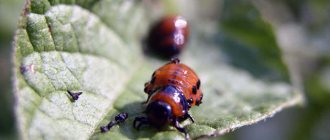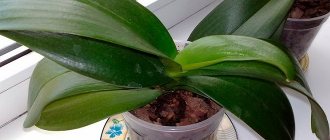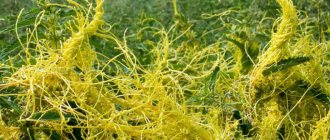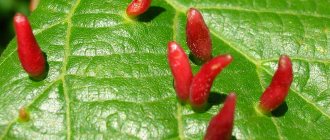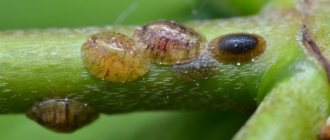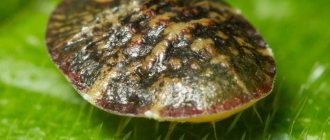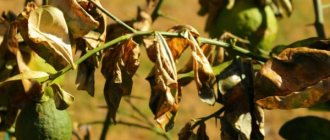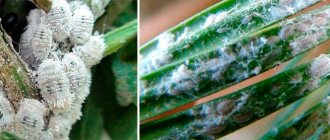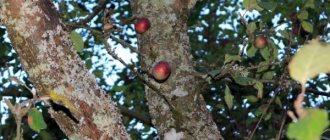Codling moth
How to get rid of bindweed in the garden - modern and folk methods of control
The codling moth lives in all regions of the Russian Federation where fruit growing is developed. The gray or brownish nocturnal insect feeds on fruits and destroys 90% of the crop during the season.
Sexually mature individual
Life cycle
The pest goes through several stages, from larva to moth.
Mature individual of the first generation
Sexually mature individuals fly to gardens when the ovaries are formed, and over the course of 1.5-2 months they actively mate and lay eggs. The pest attaches them to the outer and inner parts of the leaf plate.
Egg
The embryo begins to develop in it - from 9 to 12 days. For successful formation, a temperature of 20-22 degrees is needed.
Important! Developing embryos in the third and second generation go through all stages in 3-5 days.
Phases of development
Larva (caterpillar)
The young appear on the 15th or 17th day after flowering, and after 1-3 hours they move to the fruits. Further development begins:
- the pest covers the fruit with cobwebs;
- within half an hour he finds a weak spot and gnaws through it;
- Having penetrated it, he turns his head towards the exit and closes the passage with a mixture of cobwebs and pulp;
- after 48 hours it sheds;
- after 2 days sheds again;
- after destroying the seeds, it changes the skin again;
- eats the exit and moves to another fruit.
Important! During the season, one individual destroys 3 fruits. A mature individual creates a cocoon in the ground or bark and falls asleep until the spring of next year.
Doll
When warming reaches 8 degrees, the transition to the pupation stage begins. It develops from 14 to 25 days and degenerates into a moth.
Prevention and control
If you encounter codling moths in the fall, then traps or spraying will no longer help; immediately begin to carry out preventive measures for next year’s new crop.
Dig up the row spacing and the soil around the tree trunks in order to destroy the caterpillars that have settled there to spend the winter.
- Examine the tree carefully. Dead, damaged bark, infected branches and leaves must be collected and destroyed.
- Since the larvae crawl onto healthy fruit at night, it is very important to collect fallen fruit and bury it.
IMPORTANT : the depth for disposal of fruits spoiled by the codling moth must be at least 0.5 meters.
During the growing season, the following is recommended:
- If the larvae have already been deposited, and in large numbers, then you can use a biological weapon against the eastern moths - an entomophage called Trichogramma. The larvae of these parasites destroy the eggs and thus clean the gardens. Larvae of the Braconid species Ascogaster also parasitize eggs.
- You can set traps with scents (pheromones), which will also attract male codling moths and keep them glued to you.
ATTENTION : given that codling moths are afraid of direct sunlight and also fly quite high, traps are most effective when hung at a height of about 3 m and on the west side.
- In large gardens, it makes sense to use chemical treatments for trees (Decis pro, Calypso, Intavir, Match 050 EU).
In the very first days of the caterpillars emerging from the cocoons, or even better, the day before, the first spraying is carried out, then repeated every 2 weeks. Do this up to 5 times (on late-ripening apple trees).But remember that the more chemicals, the more harm to human health.
- A more gentle way is to use the phytoncidal properties of some other plants. Wormwood, pine needles, tansy, and all parts of tomatoes have proven effective. Decoctions and infusions from them can be sprayed on trunks and branches, thereby repelling pests.
- They attract natural plant protectors – birds – by all means. Birdhouses and feeders are made for this purpose.
- Methods for manually collecting apple moths are also used. To do this, burlap rings are placed on tree trunks, which are tied tightly at the top and loosely at the bottom. Caterpillars crawl from below and remain in these traps.
ADVICE : stop using chemicals only at the beginning of summer, long before the apples finally ripen.
DON'T FORGET : you need to collect and neutralize accumulated moths from traps at least once a week.
For more information on how to properly deal with codling moth, watch the video below:
Oriental codling moth
Aphids on roses - how to fight, folk remedies
Distributed in the middle and southern regions, Crimea. The pest attacks shoots and fruits and is capable of destroying the entire crop.
Important! The import of seedlings from the habitats of the eastern codling moth is prohibited.
Eastern variety
Life cycle
The insect goes through standard stages of development.
Mature individual of the first generation
After warming up to 14 degrees, pests begin to fly out at dusk or in cloudy weather. Laying eggs of the 1st generation on the foliage begins after 72 hours and lasts 1-2 weeks.
Important! The second and subsequent generations can lay eggs on stalks and fruits.
Egg
The development of embryos takes from 3 to 12 days - the period depends on the temperature.
Larva (caterpillar)
Formed individuals pass into the apical buds of the shoots, go deeper and destroy their structure. Pupation takes place inside the dead part or in cracks in the bark. The pest develops from 10 to 22 days, depending on the generation.
Important! The offspring of the second and next rows mature in a similar way to the codling moth.
Doll
Codling moths ripen on an apple tree, the surface of affected apples, or under fallen leaves for 5 or 10 days. The next generation forms cocoons in future wintering areas: in the bark or on the ground.
Important! The complete cycle, from egg to mature individual, takes up to one calendar month.
Pest characteristics
Symptoms and characteristics of the insect
Symptoms of damage are increased flight of butterflies 12-17 days after flowering, as well as the presence of 1 to 5 or more microscopic holes on apple ovaries. Also, the appearance of carrion in the form of apples that look full-sized, but when cut open there are gnaws inside them and the seed chamber has been eaten away.
Eastern codling moth on an apple tree
The oriental codling moth is a dangerous quarantine pest of apple trees. Because in the South it develops in five generations and one apple can sometimes be inhabited by 5-7 larvae “worms”. Because of this, it can completely deprive a summer resident of his apple harvest .
Spreading
This butterfly is distributed throughout the European part of the Russian Federation (with the exception of the tundra zone), as well as the Caucasus and Transcaucasia, the Far East and the Baikal steppes, Central Asia, Siberia, Altai, Southern Belarus and Ukraine . It is most harmful in the steppe zone of Ukraine, the Russian Federation and the mountainous Crimea.
The effect of humidity on the pest
The number of this butterfly is most strongly influenced by atmospheric phenomena.
And in particular, the massive death of its caterpillars is observed during long periods of drought and heat (almost 100%), when the moisture in the atmosphere decreases to 30%.
Note! The general death of caterpillars before they penetrate into ripening apples in the northern zone and in the Non-Black Earth Region during dry and hot July is observed much more often than usual.
Caterpillar - what is it?
A caterpillar is a small plump worm . The body is pink or pinkish-reddish in color with grayish dots and has no hairs or pubescence.
The head and cephalothorax are chitinous, reddish-brownish in color, dark and stand out brightly against the apple background. True legs with walking claws are observed.
The hind legs, which are not real, also have claws. The body length of the caterpillars sometimes reaches two centimeters. Below you can see what a codling moth looks like on an apple tree - photos in different life cycles:
Apple codling moth caterpillar.
Codling moth butterfly.
Life cycle of a pest
The cycle with complete transformation, characteristic of the genus of butterflies, consists of the flight of adult butterflies, their mating, the butterfly laying eggs in secluded places, the birth of first instar caterpillars, searching, penetration into an apple and the caterpillar feeding on the fruit, leaving the fruit for pupation.
Important! Due to the dynamism and presence of diapauses, the duration of each of the listed stages is variable and varies greatly among gardening zones.
Number of generations
In the north, in apple orchards, there are two generations of the common codling moth, in the south there are three generations, and for the eastern species and in the southern regions of the Russian Federation the number of generations can reach up to five.
First generation
In the northern regions of apple orchards, the first generation appears from the moment small apples grow, that is, from the end of May to the end of June . In the south it can be noted as early as the beginning of May.
Overwintering stage
In the winter period, as a rule, caterpillars of 4-5 instars enter, in impenetrable silky white cocoons. Most often this is the second or third generation of the moth in a given year.
Apple tree varieties not affected by the codling moth
At the moment, there are no varieties of apple trees that are absolutely resistant to codling moths . The only thing that gardeners have accurately noticed is that apples with tasty and very tasty pulp are more often and more intensively damaged by codling moths, but varieties of the “juice” direction are less “favorite” by caterpillars.
Treatment Chemicals
Some drugs can protect fruit plantings from attacks. They are used strictly according to the manufacturer’s instructions so as not to harm the crop and beneficial insects.
Fitoverm
When a codling moth is found on an apple tree, control methods require spraying the garden with a special composition. Fitoverm causes its death in 1 day, helps with massive dominance of the garden.
Is it possible to use herbicide
The description states that this subspecies is not used for manipulation due to the high risk of harm to trees.
Pesticides
Similar in action to insecticides, they cause the death of worms. Treatment is carried out:
- Ram;
- Tanrek;
- Confidor;
- Fastak, etc.
Important! Due to the cumulative effect, pesticides are stopped used a month before harvest.
Mixed insecticides
Complex use gives greater effect. Gardeners prefer the combination of Imidacloprid + Lambda-cyhalothrin, Thiamethox + Chlorantraniliprole.
Organophosphate insecticides
Toxic compounds with high efficiency. Gardeners use Dichlorvos and Karbofos due to their inexpensive price and low consumption.
Efficiency of funds
What helps a butterfly survive?
There are a number of factors that contribute to the fact that it is very difficult to remove the butterfly from the site. The most common are:
- a large number of pests. At a favorable time, many insects are born, and each of them, going through a life cycle, harms the fruit and produces offspring;
- many secluded places for wintering. Caterpillars pupate for the winter in all possible secluded places: in bark cracks, compost heaps, fruit storage areas, containers.
These factors ensure the survival of the codling moth and its large population.
Spraying timing
Dates vary according to regional circumstances. Seasonality and climatic conditions play a big role.
in spring
Spring cleaning begins with the appearance of sexually mature individuals. Organophosphorus substances are used in the fight, destroying both moths and caterpillars.
After flowering
Massive attacks of insects are restrained by spraying apple trees with Dimilin, Herold, Insegar. The compositions kill adult individuals, and the emerging larvae die when they try to eat the treated surfaces (after pouring the preparations onto them).
During the period of fruit ripening
Biological agents, traps and trapping belts, and homemade preparations are used. Chemical poisons during fruit ripening and harvesting are prohibited.
Dates in autumn
Cleaning begins after the leaves fall: accumulated debris is removed, trunks are prepared and whitened. In autumn, you can spray the garden after completely cleaning the area and trunks.
How often to spray
The work calendar is related to the regional location of the garden:
- with a cycle of 2 generations - process 2-4 times;
- with 3 or 4 generations - from 4 to 8 times during the growing season.
Important! Control and protection measures against the codling moth are used according to regional rules.
Spring treatment
Spraying times in regions
The work is carried out every 12 days after flowering - in the southern part of Ukraine, the Stavropol Territory and the Volga region. 10 days after budding in Krasnodar and the region, in the North Caucasus.
Important! Three manipulations are taking place in the North Caucasus region. The second after 21 days, then after 2 weeks.
Apple codling moth: how to spray trees against the pest
Spraying an apple tree against codling moth: photo
It is advisable to spray an apple tree against codling moths using the shower method. Special devices and industrial sprayers will help with this. The shower is very tightly capable of covering the entire volume of the green cover of the apple tree, completely all the shoots and even the rudiments of the apples. The consumption of the drug is significantly less.
Wind gusts do not spread the drug solution to neighboring plants, and the risk of poison getting into the neighboring crop is reduced significantly.
Ecological control methods
Safe products are designed to directly kill pests.
Pheromone traps
The design resembles a prism with 3 sides in which the bait is located. The drug contains pheromones that attract moths. When ingested, the moth sticks to the adhesive tape and dies within 6 hours.
Important! The design needs to change the bottom every week. One trap is enough for all insects living on 3 apple trees.
Fighting codling moth on apple trees using folk remedies
Homemade preparations include decoctions, infusions, and mechanical removal of debris from the area around the trunk. To create folk medicines, shag, tomato and potato tops, and wormwood are used.
Methods without chemicals
Common methods include preparing a special “compote”: a lot of sugar is added to a regular drink. The prepared liquid is poured into a deep plate and placed near the trees.
Important! A lantern is installed next to the trap to attract moths. This approach will help fight and reduce their numbers by up to 30%.
Hunting belts
Hunting belts
The creation of specialized belts is considered an effective and proven technique to help remove butterflies. Thick fabric (burlap, etc.) is soaked in a toxic substance and tightly wrapped around the barrel. The procedure is carried out before the first appearance of insects.
Important! If a summer trap is used for destruction, then poison must be applied to it regularly. When used as a catch net, it is periodically freed from the moth, which is shaken out into liquid soap.
Glue composition
The specialized composition is easy to prepare at home. To create a toxic substance take:
- resin - 10 hours;
- garden pitch - 2 hours;
- rosin and paraffin - 1.5 hours each.
The ingredients are poured into a bowl, heated and stirred into a homogeneous mass. As a result, the preparation should resemble a thick paste.
Integrated Protection
This is a set of procedures that help destroy the number of moths in the main phases of life (caterpillars, butterflies). Proven methods include the phased use of mechanical, agrotechnical and physiological methods. Preventive measures reduce the risk of pest attacks to a minimum, and timely care eliminates their presence.
The danger of codling moths is the massive destruction of crops. Regular inspection of fruit trees in the summer, in June-July, will prevent their reproduction, laying of eggs and further development in cycles.
What time to spray an apple tree against codling moth
Every gardener simply must know how and especially during what periods to spray against codling moths. Each region has different time frames. Even the spring period occurs differently every year.
It simply won’t be possible to set any time frames, because the definition of each period occurs differently, on the spot. Just don’t miss the moment, for example, during the butterfly’s active summer. It also depends on the number of individuals and the speed of spread.
Spring!
During this period, it is recommended to use organophosphates. The pest is completely exterminated at the birth stage. The caterpillar is simply physically unable to reach the fruit at this age, so the result of spraying will be almost 100%.
It is worth using: Admiral, Zolon, Calypso, Chlorpyrifos and a number of other products. A group of drugs that can regulate the development and growth of insects. The adult begins to lay eggs on the already poisoned surface, so the caterpillar has no chance of survival.
You can also use the poisonous compound Chlorantraniliprole + Thiamethoxam;
Summer: the crop has bloomed, fruits have set, mass ripening begins
During the ripe period, apples should never be treated with chemicals. At the moment, pheromone traps, belts, biological products, and decoctions of herbs dangerous to the caterpillar come to the rescue. The method is used for summer and autumn ripening apple trees.
Important!!! No chemicals or synthetic poisons;
Autumn time!
How beautiful she is. The long-awaited harvest has been harvested. Mass leaf fall begins. The time has come to do a complete, fruit-safe, garden treatment. Any remedy can be used. Spray the crown of the apple tree with chemicals. Old bark from the trunk and branches must be removed using special garden scrapers. It is not advisable to carry out all these procedures before the autumn period.
The first stage of spraying at the beginning of the growing season for an apple tree is early spring and early summer. Before abundant flowering begins. This process consists of two stages: before and after flowering. The period ends after fruit set.
How often do you need to spray? Places where at least two generations of codling moths form on winter varieties of apple trees must be treated at least 4 times. Summer varieties require less treatment, no more than two sprays.
In those regions where the butterfly can breed up to three generations, experience recommends spraying summer apples five times, and winter varieties should be sprayed 7 times.
Daily time for treating apple trees against codling moths
It is advisable to choose cloudier weather; there should be no wind at all. Carry out the procedure in the early hours or after sunset. Daytime changes in weather can reduce the effects of the poison. Windy weather increases the risk of pesticides spreading to neighboring crops and areas.
If we take the south of Ukraine, the Lower Volga region, the Stavropol Territory or the Rostov region, then they have their own time frames for processing apple trees. Flowering ends and only after 13-15 days can it be sprayed. The first caterpillars have appeared, count down approximately 18 days and begin processing the wood.
Northern Caucasus, Krasnodar Territory: 11 days after the mass flowering of apple trees - do the first stage of processing. The second period is 21 days after the first. If you find caterpillars in falling apples, start the third stage of processing. The fourth period is on the twentieth day after the third. Four stages are enough.
But if a situation of mass caterpillar activity arises, perform the fifth treatment; this applies only to winter varieties.
Harm
The goal of the moth caterpillar is to penetrate the seed part of the apple and eat it. After that, she leaves the apple and goes looking for another. Over the course of one season, the caterpillar can damage three large or 5 small-sized fruits. As a result, the damaged fruit falls off and loses its presentation.
Gardeners observe damage from the caterpillar under conditions of a mild winter and in the absence of protective actions. In such cases, gardeners record crop losses of up to 90%.
Description and appearance of the pest
In uncultivated areas, an inconspicuous insect can completely destroy a fruit crop in a fairly short period of time. The codling moth butterfly is ubiquitous; it can be found throughout Russia.
More often, gardeners encounter this moth in the dark - the insects actively fly towards the light. They easily adapt to the local landscape, skillfully camouflaging themselves to match the color of tree bark. Butterflies have a peculiar pattern of dark brown spots placed transversely on gray wings.
There are other distinctive features:
- the tops of the wings are decorated with yellow oval patches;
- body length – from 8 to 12 mm;
- wingspan reaches 16-23 mm;
- when folded, they take on a roof-like shape.
The biology of the codling moth is such that during a season it is capable of producing 3 generations of leaf rollers, managing to lay from 50 to 200 small (up to 1 mm) light green eggs.
Attention! The butterfly itself does not pose a threat to garden plantings. But the caterpillars that appear on the apple tree and other fruit trees are a real scourge that destroys the harvest.
The larvae of the codling moth are larger than the adult individual - they reach 22 mm in length. They have a pinkish coloration of a warty body, on which a brown head clearly stands out. Having pupated, the caterpillar decreases in size and becomes light brown or golden beige.
Larva
What does an infected tree and fruit look like?
Apple infected with codling moth
The first signs of damage are visible in the middle of the growing season. At this time, the first harvest begins to ripen. When examining fruits that have fallen to the ground, you can find 1-2 holes on the side. This is the point where the caterpillar enters the fruit. The larva penetrates the flesh to the length of the body, turns around and seals the entrance hole with stubs and cobwebs. The caterpillar feeds inside, moves, making passages .
She gets to the seed chamber and eats the seeds, leaving the shells intact. Then the pest gets out and crawls onto another fruit.
Each caterpillar can damage 2-3 fruits . Infested with caterpillars, fruits develop poorly, turn yellow and fall prematurely along with the larvae. You can often see that under the crowns of trees the ground is completely covered with carrion . Such a crop is poorly stored and gradually rots.
Caterpillars damage not only the early harvest, they are dangerous throughout the summer. For the winter, the larvae hide in cracks under the bark, near the root collar, in the top layer of soil , under plant debris. They enter a state of rest (diapause), wrapping themselves in a dense silky cocoon.

